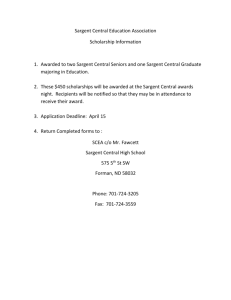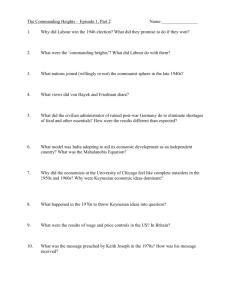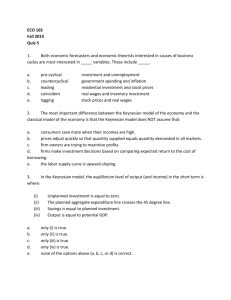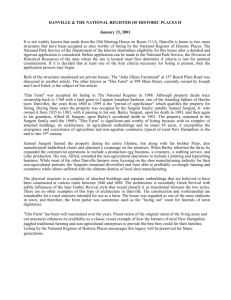To Full Employment: the ‘Keynesian Experience’ and After
advertisement
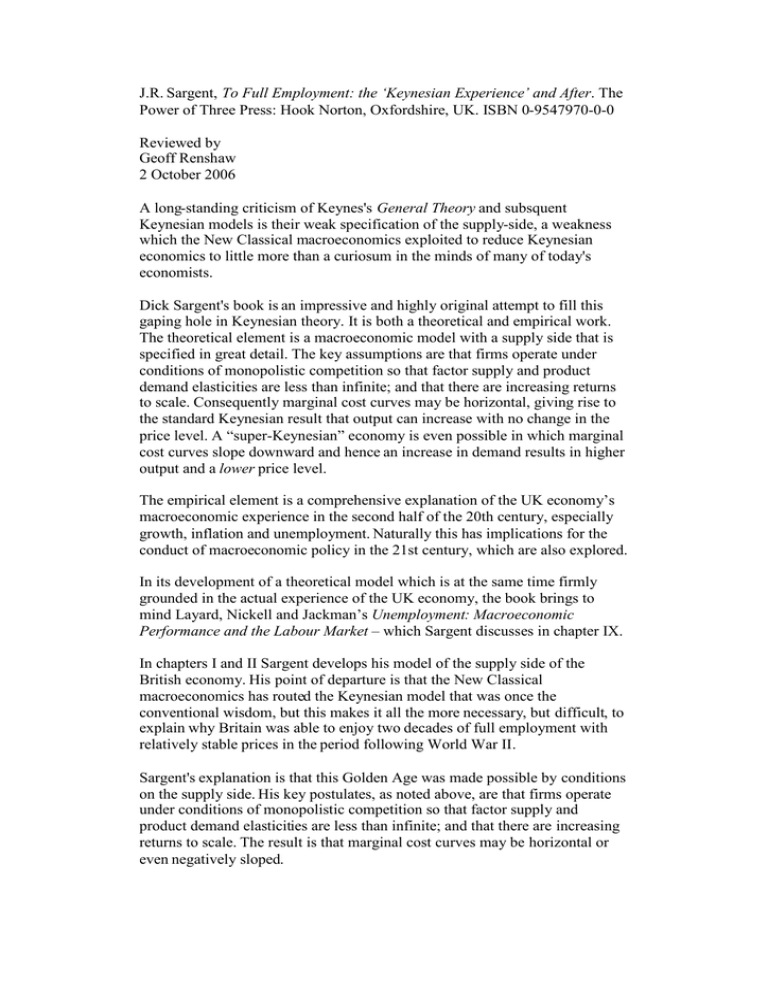
J.R. Sargent, To Full Employment: the ‘Keynesian Experience’ and After. The Power of Three Press: Hook Norton, Oxfordshire, UK. ISBN 0-9547970-0-0 Reviewed by Geoff Renshaw 2 October 2006 A long-standing criticism of Keynes's General Theory and subsquent Keynesian models is their weak specification of the supply-side, a weakness which the New Classical macroeconomics exploited to reduce Keynesian economics to little more than a curiosum in the minds of many of today's economists. Dick Sargent's book is an impressive and highly original attempt to fill this gaping hole in Keynesian theory. It is both a theoretical and empirical work. The theoretical element is a macroeconomic model with a supply side that is specified in great detail. The key assumptions are that firms operate under conditions of monopolistic competition so that factor supply and product demand elasticities are less than infinite; and that there are increasing returns to scale. Consequently marginal cost curves may be horizontal, giving rise to the standard Keynesian result that output can increase with no change in the price level. A “super-Keynesian” economy is even possible in which marginal cost curves slope downward and hence an increase in demand results in higher output and a lower price level. The empirical element is a comprehensive explanation of the UK economy’s macroeconomic experience in the second half of the 20th century, especially growth, inflation and unemployment. Naturally this has implications for the conduct of macroeconomic policy in the 21st century, which are also explored. In its development of a theoretical model which is at the same time firmly grounded in the actual experience of the UK economy, the book brings to mind Layard, Nickell and Jackman’s Unemployment: Macroeconomic Performance and the Labour Market – which Sargent discusses in chapter IX. In chapters I and II Sargent develops his model of the supply side of the British economy. His point of departure is that the New Classical macroeconomics has routed the Keynesian model that was once the conventional wisdom, but this makes it all the more necessary, but difficult, to explain why Britain was able to enjoy two decades of full employment with relatively stable prices in the period following World War II. Sargent's explanation is that this Golden Age was made possible by conditions on the supply side. His key postulates, as noted above, are that firms operate under conditions of monopolistic competition so that factor supply and product demand elasticities are less than infinite; and that there are increasing returns to scale. The result is that marginal cost curves may be horizontal or even negatively sloped. 2 Given these marginal cost curves, with several other variables held constant an aggregate supply function is derived giving profit-maximising output as a function of the real interest rate. This supply curve, labelled SS, is superimposed upon a conventional IS/LM model. Full equilibrium of the economy is then at the intersection of all 3 schedules, where the level of output not only clears the goods market but is also consistent with profit maximisation. Due to the key assumptions of monopolistic competition and increasing returns it is possible for the SS curve to be positively or negatively sloped in output/real interest rate space. The impact of fiscal and monetary policy is then analysed. Outcomes depend on whether the SS curve is negatively or positively sloped; whether it is steeper or flatter than the IS curve (if negatively sloped); and whether it is steeper or flatter than the LM curve (if positively sloped). Qualitatively, the outcome may be New Classical or Keynesian, but various forms of instability are also possible. However, none of these outcomes corresponds straightforwardly to the experience of the Golden Age, so in chapters III and IV the author then introduces another explanation; a sustained fall in the cost of capital to firms. He assembles and examines data on the cost of capital in the UK and argues that the required rate of return fell continuously in the 1950s and 60s due to a reduction in risk premia and in the taxation of profits. He examines in detail the consequences for all of the variables in his model of a fall in the cost of capital. Perhaps the key conclusion of the book is found in chapter VI, where Sargent argues that the Golden Age was brought to an end by a rising marginal capital/output ratio (resulting from the fall in the cost of capital and the reduction in risk premia). In his model a rising capital/output ratio causes marginal cost curves to become more steeply upward sloping. The impact of the Barber boom of 1971-2, in which a large demand stimulus had a large effect on prices but relatively little effect on output, is evidence of this. In chapter VIII the modelling shifts from a stationary to a growing economy. Sargent introduces a Phillips-type relation in which there is a “normal” real wage change which is modified by the level of unemployment. This allows for tax wedges in the form of employers’ social security charges and employees’ income taxes, as well as factors such as changes in relative prices. These and other factors mean than the relationship between the level of unemployment and the rate of change of real wages is not unique. This explains the apparent instability of Phillips curves. He identifies five distinct phases: 1953-71; 197276; 1977-83; 1984-90; and 1991 onward. Chapter IX is concerned with policy issues for the present and future. A key issue is the NAIRU, which has become the new orthodoxy in both theory and policy. Sargent points out the dangers of defining equilibrium in terms of a NAIRU. His model does not possess a NAIRU. Instead, given other parameter values, there is indeed a unique rate of unemployment at which inflation remains constant, but the equilibrium is a stable one; i.e. inflation does not 3 accelerate if unemployment is below this rate. This contrasts with Layard, Nickell and Jackman’s Unemployment. Their model has much in common with Sargent’s, in that both firms and workers have market power. But their model has a NAIRU, where Sargent’s does not. Sargent argues convincingly that this is due to a misspecification by Layard et al. The final three sections of this chapter consider the role of supply side policies in reducing unemployment. Sargent shows that increased education and training is less effective than increasing the incentive to invest or taxes on labour. Increasing competition in the labour market, thereby increasing labour supply elasticity to the firm, is also effective. He also examines the impact of increased labour productivity on real wages, noting that if real wages rise as fast as labour productivity the effect on employment is neutralised – something that the advocates of supply side policies frequently, and conveniently, overlook. Indeed there is a close analogy between the way in which supply-side policies are undermined by the expectations they generate for real wages, and the way in which demand-side policies are undermined by the expectations they arouse about prices. This means that policies to influence the expected growth of real wages have an important role. Sargent argues that the apparent increase in trade union militancy in the 1970s reflected their failure to reduce expectations of real wage growth in response to higher oil prices and lower productivity growth. In contrast, he believes that real wage restraint explains in large part the modest inflation during the upswing in the second half of the 1990s (and, presumably, since then). The problem is that this restraint may erode if unemployment continues to fall. This is a lengthy book, and the number of equations and variables is somewhat daunting at first sight. However, total immersion in the algebra is unnecessary as every step in the reasoning is fully explained in the text. Sargent writes very clearly and with a light touch, and the book is a pleasure to read.
